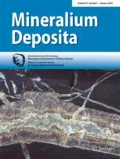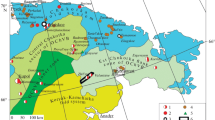Abstract
The Quebrada Marquesa Quadrangle in Chile exhibits a series of mineralizations comprising manto-type manganese and copper deposits of Lower Cretaceous age, and copper and silver veins of Tertiary age. The deposits are hosted by volcanic and volcaniclastic units of the Arqueros (Hauterivian-Barremian) and Quebrada Marquesa (Barremian-Albian) Formations. Three episodes of manganese mineralization (Mn1-3) are recognized within the study area. Hydrothermal activity leading to episodes 1 and 3 was of minor importance, while the second one (Mn2) gave rise to major manto-type deposits of both manganese and copper in the Talcuna mining district. Extensional faulting during Tertiary time resulted in block faulting and the unroofing of the oldest andesitic volcanics and marine sediments (Arqueros Formation). This episode was accompanied by magmatic and hydrothermal activity leading to vein formation in the Arqueros (Ag) and Talcuna (Cu) districts. The latter veins cross-cut the previous manto-type copper deposits. Ore mineralogy is similar in both styles of mineralization (manto- and vein-type) and consists mainly of chalcopyrite and bornite, with variable amounts of galena, tetrahedrite (vein-related), chalcocite, sphalerite, pyrite, hematite, digenite and covellite. Alteration processes at Talcuna can be divided into two categories, those related to the Lower Cretaceous manto-type episode (LK alteration: chlorite-epidote-calcite-albite, prehnite, zeolite), and those associated with the locally mineralized normal faults of Tertiary age (Tt alteration: chlorite-calcite, sericite). The Arqueros silver veins display an ore mineralogy consisting of arquerite, argentite, native silver, polybasite, cerargyrite and pyrargyrite-proustite; associated alteration includes strong chloritization of the country rock. The manto-type deposits formed from fluids of salinity between 11 and 19 wt.% NaCl equivalent and temperatures between 120 and 205 °C. Mineralizing fluids during the vein-type stage circulated at lower temperatures, between 70 and 170 °C, with salinity values in a wide range from 3 to 27 wt.% NaCl equivalent. This distribution of salinities is interpreted as the result of the complex interplay of two different processes: boiling and fluid mixing; the former is considered to control the major mineralogical, textural and fluid inclusion features of the vein-type deposits. We suggest that the Lower Cretaceous mineralization (manto-type stage) developed in response to widespread hydrothermal activity (geothermal field-type) involving basinal brines.
Similar content being viewed by others
Author information
Authors and Affiliations
Additional information
Received: 18 July 1997 / Accepted: 28 January 1998
Rights and permissions
About this article
Cite this article
Oyarzun, R., Ortega, L., Sierra, J. et al. Cu, Mn, and Ag mineralization in the Quebrada Marquesa Quadrangle, Chile: the Talcuna and Arqueros districts. Mineral. Deposita 33, 547–559 (1998). https://doi.org/10.1007/s001260050171
Issue Date:
DOI: https://doi.org/10.1007/s001260050171




